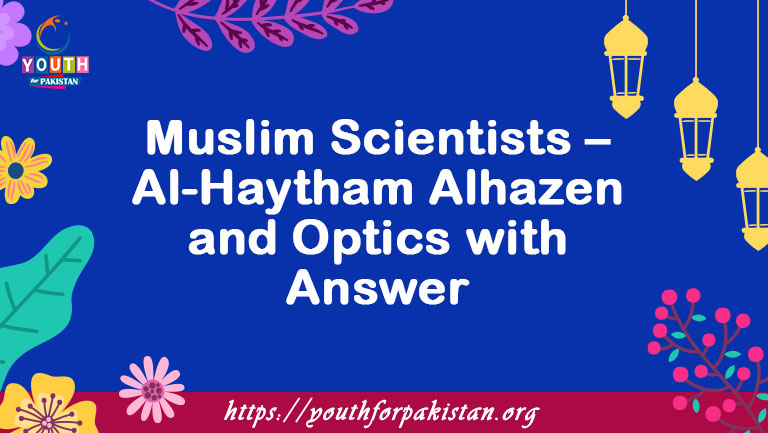The following are Muslim Scientists – Al-Haytham Alhazen and Optics MCQs with answers related to Islamic Studies. We have arranged the most important and repeated MCQs in all the competitive examinations. The students can clear their concepts for Muslim Scientists – Al-Haytham Alhazen and Optics MCQs online quiz by attempting these.
Muslim Scientists – Al-Haytham Alhazen and Optics Online MCQs with Answers
Who is considered the “Father of Optics”?
A) Ibn Sina
B) Al-Razi
C) Al-Haytham
D) Al-Kindi
In which century did Al-Haytham live?
A) 7th century
B) 9th century
C) 11th century
D) 13th century
Al-Haytham is best known for his contributions to which field of science?
A) Chemistry
B) Mathematics
C) Astronomy
D) Medicine
What is the Latinized name of Al-Haytham’s most famous work on optics?
A) Al-Khwarizmi
B) De Magnete
C) Kitab al-Manazir
D) Almagest
Al-Haytham made significant advancements in the understanding of which optical phenomenon?
A) Reflection
B) Refraction
C) Diffraction
D) Dispersion
What is Al-Haytham’s birthplace?
A) Baghdad, Iraq
B) Cairo, Egypt
C) Cordoba, Spain
D) Isfahan, Iran
Which scientific method is often attributed to Al-Haytham?
A) The Scientific Method
B) The Hypothetico-Deductive Method
C) The Experimental Method
D) The Deductive Method
Al-Haytham’s work on optics had a significant influence on the works of which European scientist?
A) Isaac Newton
B) Galileo Galilei
C) Johannes Kepler
D) Albert Einstein
Which of the following is not a book written by Al-Haytham?
A) Book of Optics
B) Book of Healing
C) Book of Demonstrations
D) Book of Alchemy
Al-Haytham’s research on vision and light laid the foundation for the understanding of:
A) Quantum Mechanics
B) Geology
C) Optics
D) Botany
Al-Haytham is also known for his work in what area of mathematics?
A) Algebra
B) Calculus
C) Geometry
D) Trigonometry
Which Islamic Golden Age scholar is often associated with Al-Haytham due to their collaboration on scientific works?
A) Al-Khwarizmi
B) Al-Farabi
C) Ibn al-Haytham
D) Al-Razi
Al-Haytham’s investigations into the behavior of light led to the understanding of which optical instrument?
A) Telescope
B) Microscope
C) Spectrometer
D) Camera Obscura
Al-Haytham’s experiments on refraction challenged the ideas of which ancient Greek philosopher?
A) Aristotle
B) Plato
C) Euclid
D) Ptolemy
What is the Arabic name by which Al-Haytham is often referred to in historical texts?
A) Al-Kindi
B) Ibn al-Haytham
C) Al-Sufi
D) Al-Farabi
Al-Haytham’s work on optics included the study of which phenomenon related to lenses?
A) Gravitational lensing
B) Chromatic aberration
C) Infrared absorption
D) Radioactive decay
What is the name of the theory that Al-Haytham developed to explain how vision works?
A) The Theory of Evolution
B) The Emission Theory
C) The Intromission Theory
D) The Heliocentric Theory
Al-Haytham’s research on catoptrics focused on the study of:
A) Mirrors
B) Lenses
C) Prisms
D) Spectroscopy
In addition to his scientific contributions, Al-Haytham also made advancements in which field of engineering?
A) Civil Engineering
B) Mechanical Engineering
C) Electrical Engineering
D) Software Engineering
Al-Haytham’s works were preserved and studied in Europe during the:
A) Dark Ages
B) Renaissance
C) Victorian Era
D) Industrial Revolution
What was the primary language in which Al-Haytham wrote his scientific works?
A) Greek
B) Latin
C) Arabic
D) Persian
Al-Haytham’s groundbreaking work on optics laid the foundation for the development of which modern device?
A) X-ray machine
B) Laser printer
C) Digital camera
D) GPS receiver
Al-Haytham’s investigations into the nature of light and vision had a profound impact on the field of:
A) Architecture
B) Music
C) Medicine
D) Optometry
What is the full name of Al-Haytham’s famous work on optics, often referred to simply as the “Book of Optics”?
A) Kitab al-Manazir wa’l-Hakim
B) Al-Shifa
C) Al-Jabr wal-Muqabala
D) Almagest
Al-Haytham’s research on optics helped disprove the ancient Greek idea that vision was caused by:
A) Rays emitted from the eyes
B) The movement of the eyeball
C) Reflected images on the retina
D) The soul’s connection to the eye
Al-Haytham’s work on the nature of light influenced the understanding of which concept in modern physics?
A) General relativity
B) Quantum mechanics
C) Thermodynamics
D) Chaos theory
Which famous Renaissance scientist acknowledged Al-Haytham’s contributions to optics in his own work?
A) Leonardo da Vinci
B) Copernicus
C) Galileo Galilei
D) Johannes Kepler
Al-Haytham’s experiments on the behavior of light played a key role in the development of which scientific instrument?
A) Microscope
B) Telescope
C) Barometer
D) Gyroscope
Al-Haytham’s work on optics included studies on the formation of images by which optical element?
A) Prisms
B) Mirrors
C) Lenses
D) Filters
Al-Haytham’s work in optics helped establish the scientific understanding of the phenomenon known as:
A) Total internal reflection
B) Magnetic resonance
C) Gravitational attraction
D) Nuclear fusion
Al-Haytham’s contributions to the study of optics included experiments with which type of lens?
A) Convex lens
B) Concave lens
C) Fresnel lens
D) Achromatic lens
Al-Haytham’s work on optics helped explain the phenomenon of what happens to light when it passes through a medium at an angle?
A) Reflection
B) Refraction
C) Dispersion
D) Polarization
Which famous Greek mathematician’s work greatly influenced Al-Haytham’s studies in optics?
A) Euclid
B) Archimedes
C) Pythagoras
D) Diophantus
Al-Haytham’s investigations into the nature of light led to the development of which optical device used for artistic purposes?
A) Kaleidoscope
B) Hologram projector
C) Camera obscura
D) Prism spectroscope
Al-Haytham’s experiments with pinholes and lenses helped establish the principles of:
A) Aeronautics
B) Geology
C) Perspective in art
D) Clockmaking
Al-Haytham’s work on optics had a significant impact on the field of:
A) Neurology
B) Agriculture
C) Astronomy
D) Psychology
Which branch of mathematics did Al-Haytham contribute to by solving problems related to conic sections?
A) Algebra
B) Calculus
C) Geometry
D) Statistics
Al-Haytham’s investigations into the properties of light and vision had practical applications in the development of:
A) Telescopes
B) Windmills
C) Steam engines
D) Water pumps
Al-Haytham’s work on optics contributed to the understanding of which natural phenomenon responsible for creating rainbows?
A) Lightning
B) Rain
C) Earthquakes
D) Volcanic eruptions
What was the title of Al-Haytham’s treatise on the theory of colors and color perception?
A) “The Spectrum of Light”
B) “On the Rainbow”
C) “The Book of Healing”
D) “The Book of Optics”
Al-Haytham’s work on optics contributed to the understanding of how light interacts with which type of material?
A) Metals
B) Gases
C) Liquids
D) Solids
Al-Haytham’s contributions to the understanding of optics and vision laid the groundwork for the development of modern:
A) Television
B) Lasers
C) Photography
D) Atomic theory
Al-Haytham’s investigations into the behavior of light influenced the development of which branch of modern science?
A) Biochemistry
B) Meteorology
C) Genetics
D) Quantum physics
Which famous philosopher of the Islamic Golden Age was a contemporary of Al-Haytham and contributed to the development of science?
A) Al-Farabi
B) Avicenna (Ibn Sina)
C) Al-Razi
D) Al-Kindi
Al-Haytham’s experiments with lenses and mirrors contributed to the understanding of which phenomenon related to light?
A) Fluorescence
B) Interference
C) Diffraction
D) Polarization
Al-Haytham’s research on vision and light challenged the prevailing ideas of which ancient Greek philosopher’s theories on vision?
A) Euclid
B) Ptolemy
C) Aristotle
D) Archimedes
Al-Haytham’s work on optics and the nature of light contributed to the development of which branch of modern science?
A) Geology
B) Psychology
C) Economics
D) Epidemiology
Al-Haytham’s investigations into the behavior of light led to advancements in which field of technology?
A) Information technology
B) Aerospace engineering
C) Solar energy
D) Robotics
Which European scientist is often credited with rediscovering and spreading Al-Haytham’s work on optics during the Renaissance?
A) Isaac Newton
B) Leonardo da Vinci
C) Johannes Kepler
D) Galileo Galilei
Al-Haytham’s investigations into the nature of light contributed to the understanding of which fundamental property of light?
A) Speed of light
B) Polarization of light
C) Dispersion of light
D) Reflection of light










